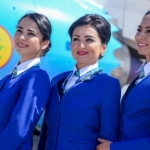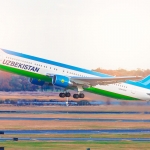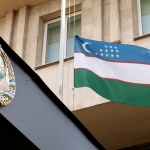07 SEPTEMBER 2019 Y.
Just as Uzbekistan is the heart of Central Asia, the Ferghana Valley is the heart of Uzbekistan. Eight million people, one third of the population, live in this fertile flood plain of the Syr Darya river sweeps down from the Pamirs into a valley approximately 300 kilometres (190 miles) long and 170 kilometres (105 miles) wide, surrounded by spurs of the Tian Shan—the Chatkal range to the north, Ferghana to the east, and the Pamir-Alai to the south.
The best approach for traders and conquerors was through the Khodjent Gates to the west, where the river leaves the valley before the Hunger Steppe. Stock-breeding tribes came this way in the Bronze Age, mixing with local farming peoples. Rock-carvings high in the mountains, such as Saimaly-Tash in the Ferghana range, reveal and ancient scenes of hunting and agriculture. The town of Khodjent dates back to the conquests of Alexander the Great in 329 ВС, when the Macedonian founded his ninth Alexandria here, Alexandria Eskhate (the furthest)…
History of Ferghana Valley
Two centuries later the Chinese envoy and Silk Road pioneer Zhang Qian reached the valley, after a decade spent detained by the nomads harrying China’s borders. He welcomed Fergana’s more sophisticated civilization. The people are settled on the land, plowing the fields and growing rice and wheat. They also make wine out of grapes. The region has many fine horses which sweat blood; their forebears are supposed to have been foaled from heavenly horses. The people live in houses in fortified cities. . . the population numbers several hundred thousand. They fight with bows and spears and can shoot from horseback.
Descended from legendary dragon-horses of the far west, the blood-sweating horses of Ferghana coveted for their great size and speed by the Han emperor, Wudi. They formed the focus of Chinese campaigns that blasted open East-West trade routes, taking silk to Europe and wine to China. The blood was less celestial perspiration than the work of a busy parasite, but the door had been opened to commercial and cultural exchange. Sogdian merchants proved consummate Silk Road middlemen. Buddhist remains such as the temple near Kuva demonstrate the intellectual growth.
Arab invasion followed Turkic and Chinese as the valley became the Samanid empire’s frontier against the heathen Turks. Leadership shifted from Kasansay to Aksiketh, Uzgen and Andijan, where Tamerlane’s great-great-great grandson Babur, the last Timurid and the first Mogul, was born in 1483. His memoirs speak of great pride in a homeland he was forced to abandon by the triumphant Uzbek Shaybanid dynasty. From the early 19th centure, the khanate of Kokand expanded beyond Ferghana into Central Asia’s third power. Economic growth sponsored Islamic learning and public works in traditional styles, while territorial gains sparked frequent warfare with Bukhara.
When Soviet aggression succeeded Tsarist colonization, the valley arose in the basmachi (bandit) movement, Central Asian mujaheddin versus Russian infidels. As last resistance was eliminated, national delimitation from 1924 carved today’s ethnic jigsaw, where pieces are shared by the republics of Uzbekistan, Kyrgizstan and Tajikistan. Divide and rule tactics have left national islands adrift in foreign seas, like the Uzbek enclave of Shakhimardan inside Kyrgyzstan. Soviet overlordship promoted intensive agricultural and industrial development. Following the proverb ‘it is not land but water which bears fruit’, the 270 kilometre- (170-mile)- Great Ferghana Canal was dug in 1939 in only 45 days by 180,000 ‘volunteers’. Acclaimed as a grand example of the Uzbek khoshar, a collective undertaking for the common good, it typified efforts to extract the maximum from nature to placate cotton-hungry Moscow.
Independence has given internal borders a solidity never imagined by their devisors. In recent years petty disputes have occasionally exploded into pogroms between formerly ‘fraternal peoples’. The valley, the most densely populated part of Central Asia, is not just a political but also a religious barometer for the region. Throughout the Soviet era Islamic practices survived most strongly here. Foreign money now finds fertile ground for brands of Islam more extreme than local governments care for. With its overlapping cultures and hopefully interacting economies, Ferghana is a microcosm of Turkestan as it was and may be once more. Add to the intrinsic fascination stunning scenery, distinctive local architecture and traditional crafts, from silk-weaving and wood-carving to pottery and knife-making, and the result, at the very least, makes for a worthy side-trip from Tashkent, to the place locals proudly dub the ‘Golden Valley’.














